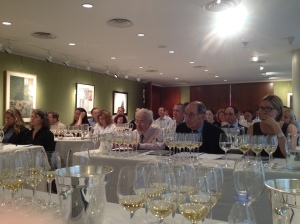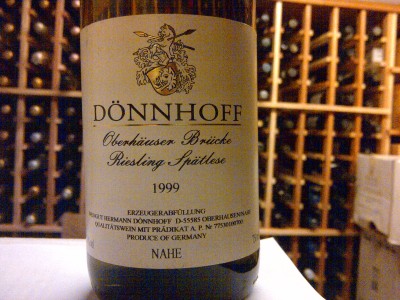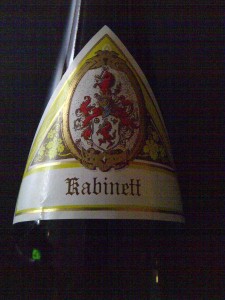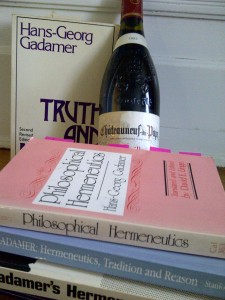I don’t want to drink ideas. I don’t drink ideology. I drink wine. As I’ve written elsewhere, I like wines that have personality. . . Expression. . . Content. . . Soul. Wines that convey a sense of place. (To paraphrase Justice Potter Stewart, you know it when you taste it.) But sometimes a group of wines can tell a story. Of course, in this instance, the story is only worthwhile if the wine (dare I say “the plot”?) is good.
One of the most damning adjectives I’ve often heard applied to a wine, I’ve concluded, is the word “interesting.” What does that mean? It’s about as descriptive as saying a wine is “nice.” While literally it should signify that the wine holds one’s interest, the word “interesting” tends to be used in an empty fashion, when someone lacks the articulation or the vocabulary to say something coherent and meaningful about a wine. “Interesting” tends to be used to describe a wine that, while not necessarily international in style, or showing “typicité” of a specific region, may be quirky, unusual – or of a style simply unknown to the taster. Sometimes it’s said for lack of anything else to say. Curiously, some wines that are described as “interesting” may be so for one sip, even two, but not sufficiently compelling to finish a bottle, much less to consider a re-purchase.
After years eschewing the use of that word, I now choose to reclaim it. The wines I discuss below happen to be very interesting, that is, they hold one’s interest for a while. The best of them are dynamic, evolving in the glass over hours, even days. While not necessarily the most complex, nor the most finessed, as a group they include some very tasty wines. And, notwithstanding my arguably snarky comment above about not caring to drink an idea, these wines also convey a young vigneron’s efforts to interpret his various terroirs.
Within this context, I’ve always found it intriguing that two producers in the same area, with similar properties, each argue for different growing and/or production methods as a means for achieving maximum terroir expression. This is part of what makes wine fun, even intellectually challenging. Who is to say whether, for example, an oxidative or reductive approach is more “true” or elicits greater expression from a specific plot of grapevines? Much of this can come down to taste, and for that I simply refer the reader to to David Hume’s essay “Of the Standard of Taste,” where he argues against a relativistic view of critical judgment.
These questions came to mind as I tasted through the range of wines by Jean Christophe Garnier. Garnier is based in St Lambert du Lattay, 11 km due south of Savennieres, on the south side of the Layon River; a town technically in the AOP Coteaux du Layon (were his Chenin vines to be botrytised and sweet.)
Originally from Brittany, Garnier worked as a sommelier and naturally became captivated with fine wine. Ultimately he migrated into wine production. He had a stage with Marc Angeli, who helped him get settled in the region. When a number of small plots in Anjou became available, he grabbed them.
So this is a story of someone who came from zero, no deep provenance in wine, no family history or patrimony. Moreover, he’s working in an area where the wines (if not nobly sweet) had little to no international recognition. It’s about someone who took a piece of property, explored and evaluated which available methods would best translate grapes from in that site into wine.
Most of his land is schistous: his “Generik” Chenin, planted on schist, limestone and marl; “La Roche” is just over a hectare of 63 year old vines planted on carboniferous soils, yielding only 20 hl/ha; and his finest plot, Bézegon, is a 0.95 ha plot of 60 year old vines on Brioverian shale, yielding 30 hl/ha.
Being of a certain time and place, perhaps, he experimented with doing things as “naturally” as possible. He didn’t understand enough about hygiene, perhaps, or didn’t realize his equipment was insufficiently temperature controlled, or perhaps questioned the notion that SO2 “had” to be used. . . . So, as they say, “mistakes were made.” But over time, he’s come up with a few distinctive practices that result in singular, yes, interesting wines:
A number of years ago he purchased a Calvados basket press, and it is this – Garnier brand, no less – that he uses for all his wines. The distinction does not end there: he presses over a period of 1-2 days, sometimes as many as three; thus we have a distinctive cidery, oxidative style, not out of place, one might argue, as it enhances the apple/quince character of the Chenin. For the reds, he extracts good color and soft tannin. The wines are fermented in old oak barrels; elevage typically is in fiberglass, concrete, or stainless tanks. I tasted these wines at one sitting, and then played with the last four over the next series of days, all maintained their integrity; the Chenins particularly continued to evolve and unfold.
Are these wines “definitive,” or should that word even apply? Do they represent the purest, or perhaps the consummate expression of the terroir? They are, at least, Garnier’s notion of such. They offer an intriguing, and tasty argument. Incidentally, these wines do not solely have geek appeal: my family, including my parents, all wine lovers but not especially discriminating in Hume’s sense, found the wines intriguing and quite enjoyable. Each person had a different preference — and yes, more than one said that the wines were “interesting.”
NV Jean Christophe Garnier Brut Nature (Vin de France) (1/3 each Grolleau/Gamay/Pineau d’Aunis) Pale, pinkish copper, very tiny perlage. Fresh, distinctive nose of spice, red fruits, mineral; delicate with hints of fresh herbs. Light-boied with delicate pétillance, a mineral focus, with strawberry fruit character; a delicate mineral texture, like finely crushed stones. Longish finish, subtly oxidative, with a mouthfilling scent. [Each lot pressed 2-3 days, then to fiberglass tanks for ~ one month; then to bottle; Clairette de Die-style production. Mostly 2011 vintage.]
2010 Jean Christophe Garnier “Perle a Boule” (Vin de France) (50/50 Grolleau/Gamay) Pale salmon but some red hue. More intense soft fruitiness than the Brut Nature, with peach notes. Light bodied, barely pétillant. Soft, subtle sweetness, delicate yet mouth filling, if not especially dynamic. Subtle mineral finish. Needs to be drunk super-fresh, at one sitting, immediately after opening the bottle.
2010 Jean Christophe Garnier Chenin “Generik” (Vin de France) 13% Light amber, a little cloudy. Appley nose, a little oxidative, like peeking into a barn filled with bruised golden delicious and razor apples. Medium bodied and bone dry, salty on the attack and segue, firm and linear. Mouth-filling and direct. [Grown on schist, limestone and marl, basket pressed for 2-3 days.]
2010 Jean Christophe Garnier Chenin “Bézigon” (Vin de France) 13.5% Medium pale straw, a little murky. Nose of quince, a bit of wet wool, chalk, bruised apples, like walking into cider barn – but no funk. Medium-bodied and bone dry, but with ballast and persistence, leading to a quiet chalky/stony/salty finish of medium length. Needs time to open out; as it does, the bruised apple and ripe quince come to the fore. A more focused vintage with less weight but more of saline character, more definition and length than the 09 that follows.
2009 Jean Christophe Garnier Chenin “La Roche” (Vin de France) Amber-yellow gold. Riper, deeper, more intense but not more complex initially – more like sticking your nose in a cider barrel. Big and broad, more powerful and reflective of the riper vintage; textured. Full palate coverage, even, a bit salty, but a shorter finish than the finer, more detailed and focused 2010 Bézegon. Lots of apple and quince.
2011 Jean Christophe Garnier Chenin “Les Tailles” (Vin de France) [a 50/50 blend of Cabernets Sauvignon and Franc, all free run; carbonic maceration over 3 months in 80/20 fiberglass/concrete; bottled after 6 months) 12.5% abv Bright, deep violet ruby. An intense, distinctive edgy and nervous nose: dark, tart blue-and blackberries, cassis, dried herbs, black currant bud, raspberry stalks, mineral. Fresh and medium-bodied, almost gulpable, with soft, almost imperceptible tannins. Well-balanced fresh acidity. Hints of smoke, mineral, a delicate smoky scrim. Opens out with high tones of tomato leaf and dried herbs. Lacking the structure and concentration of a cru Beaujolais, but more personality, weight and character than most Beaujolais-Villages. Fun! [Les Tailles is from mostly 63 Years old vines, though some young vines have been planted to replace some missing vines. It is about two hectares, mostly of silt and sand, yielding 45 Hl/Ha.]
2005 Jean Christophe Garnier “Chenin Sous Voile” (Vin de France) 14.5 abv Medium deep amber, lightly murky. Initially, a play-do, stony, bruised appley/cidery nose. (After a few days the playdo recedes) The wine has a dynamic attack, with a flash of ripe yellow fruit before the fruity fruit character suddenly collapses within itself, paradoxically leaving a a full-bodied, sherried wine of raw nuts with a salty finish. Offering full palate coverage with more weight, acidity and drive than a sherry. But it does invite one back for more, to explore odd notes of green tea, a cheesy, yeasty character, and an array of nuts. The elevated alcohol adds to the weight and breadth, but isn’t overbearing and integrates with some aeration. Provocative, but also quite appetizing if you like the style. (2 barrels made) [Garnier loves yellow wines. When he recognized that 2005 offered the right sugar/acid balance to support the flor, he seized the best grapes from his top plot and made two barrels. Five years of elevage . . . . and no more in the pipeline.






